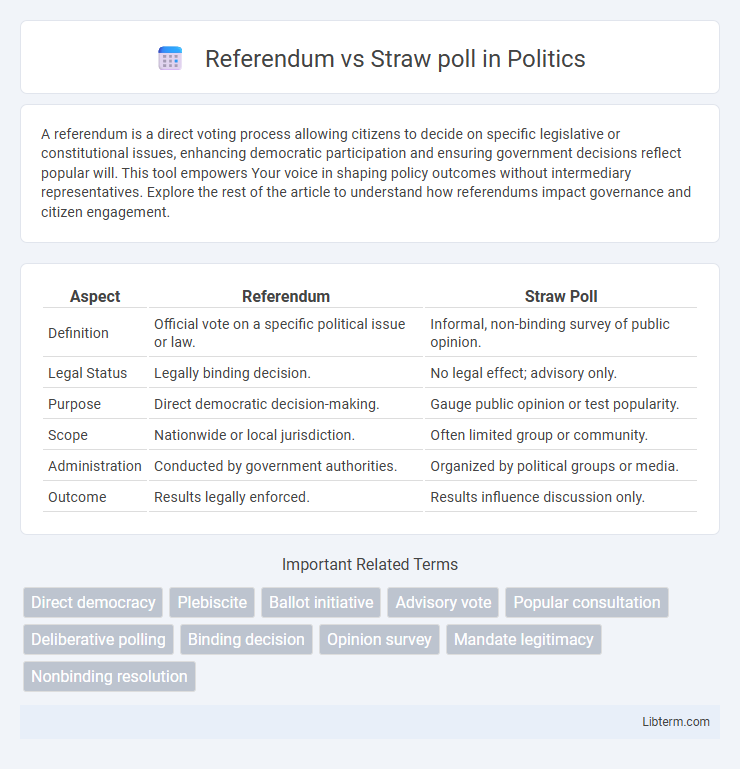A referendum is a direct voting process allowing citizens to decide on specific legislative or constitutional issues, enhancing democratic participation and ensuring government decisions reflect popular will. This tool empowers Your voice in shaping policy outcomes without intermediary representatives. Explore the rest of the article to understand how referendums impact governance and citizen engagement.
Table of Comparison
| Aspect | Referendum | Straw Poll |
|---|---|---|
| Definition | Official vote on a specific political issue or law. | Informal, non-binding survey of public opinion. |
| Legal Status | Legally binding decision. | No legal effect; advisory only. |
| Purpose | Direct democratic decision-making. | Gauge public opinion or test popularity. |
| Scope | Nationwide or local jurisdiction. | Often limited group or community. |
| Administration | Conducted by government authorities. | Organized by political groups or media. |
| Outcome | Results legally enforced. | Results influence discussion only. |
Understanding Referendums: Definition and Purpose
A referendum is a direct voting process where citizens decide on a specific legislative or constitutional issue, providing a legally binding outcome that shapes public policy. This democratic tool enables governments to gauge public opinion on critical matters such as constitutional amendments, tax policies, or social reforms. Unlike a straw poll, which is informal and non-binding, referendums hold authoritative power to enforce the decision made by the electorate.
What is a Straw Poll? An Overview
A straw poll is an informal survey used to gauge the opinion or support of a specific group on a particular issue or candidate without binding results. It is often conducted during political events or meetings to quickly assess the sentiment of participants. Unlike a referendum, a straw poll does not have legal authority or official status and is primarily a tool for measuring public opinion.
Key Differences Between Referendums and Straw Polls
Referendums are formal, legally binding votes used to decide specific policy issues or constitutional changes, often organized by governments with clear procedural rules. Straw polls are informal, non-binding surveys conducted to gauge public opinion or test support levels within a specific group without official consequences. The key difference lies in referendums' authoritative impact on lawmaking versus straw polls' role as opinion indicators without legislative power.
Legal Implications of Referendums vs Straw Polls
Referendums carry binding legal authority that can directly alter legislation or public policy, while straw polls are non-binding and serve primarily as informal indicators of public opinion. The legal implications of referendums require strict adherence to statutory procedures, voter eligibility, and formal certification processes, ensuring that outcomes have enforceable consequences. In contrast, straw polls lack legal recognition and do not impose any statutory obligations or changes in governance, limiting their influence to advisory or predictive functions.
Use Cases: When to Hold a Referendum or a Straw Poll
Referendums are best suited for making binding decisions on public policy, constitutional amendments, or significant legislative changes that require direct voter approval, ensuring legal enforceability and broad democratic participation. Straw polls serve as informal gauges of opinion within smaller groups or organizations, useful for preliminary feedback or assessing sentiment before formal decisions or official votes. Organizations should hold a referendum when they need a definitive, legally binding outcome, while straw polls are ideal when seeking quick, non-binding insights to guide future actions or discussions.
Accuracy and Reliability: Gauging Public Opinion
Referendums provide a legally binding and statistically accurate measure of public opinion, reflecting the collective will on specific issues through formal voting procedures. Straw polls, while useful for informal gauging, often lack scientific sampling methods, leading to potential biases and lower reliability in representing the broader population. The accuracy of referendums makes them a preferred tool for policymakers to make decisions with greater legitimacy and public trust.
Impact on Policy-Making: Referendum vs Straw Poll
Referendums directly influence policy-making by enabling voters to approve or reject specific laws, resulting in binding outcomes that government officials must implement. Straw polls serve as informal indicators of public opinion, lacking legal authority but potentially guiding policymakers' decisions and strategy adjustments. The definitive impact of referendums contrasts with the advisory nature of straw polls, making referendums a more powerful tool for enacting or blocking legislation.
Examples from History: Referendums and Straw Polls in Action
The 2016 Brexit referendum in the United Kingdom exemplifies a national referendum directly influencing government policy by deciding membership in the European Union. In contrast, the 1948 United States Democratic presidential primaries featured straw polls like the Gallup Poll, which gauged public opinion without binding consequences. Referendums, such as the 1995 Quebec independence vote in Canada, have legally binding outcomes, whereas straw polls serve as informal indicators of voter sentiment, exemplified by early 20th-century political conventions.
Advantages and Disadvantages of Each Method
Referendums provide a binding decision-making process, ensuring official and legally recognized outcomes that reflect the will of the populace, but they can be costly and time-consuming to organize. Straw polls offer a quick, informal gauge of public opinion, allowing organizations to test ideas without significant expense, yet their non-binding nature limits their influence on actual policy. The choice between these methods depends on whether the priority is definitive legal authority or rapid, low-cost feedback.
Choosing the Right Tool: Referendum or Straw Poll?
Choosing the right tool between a referendum and a straw poll depends on the decision-making context and desired outcome. Referendums provide legally binding results by involving the entire electorate in formal voting on specific issues, ensuring definitive public mandate. Straw polls, being informal and non-binding, serve as quick gauges of opinion among a limited group, ideal for preliminary insights or guiding future discussions.
Referendum Infographic

 libterm.com
libterm.com